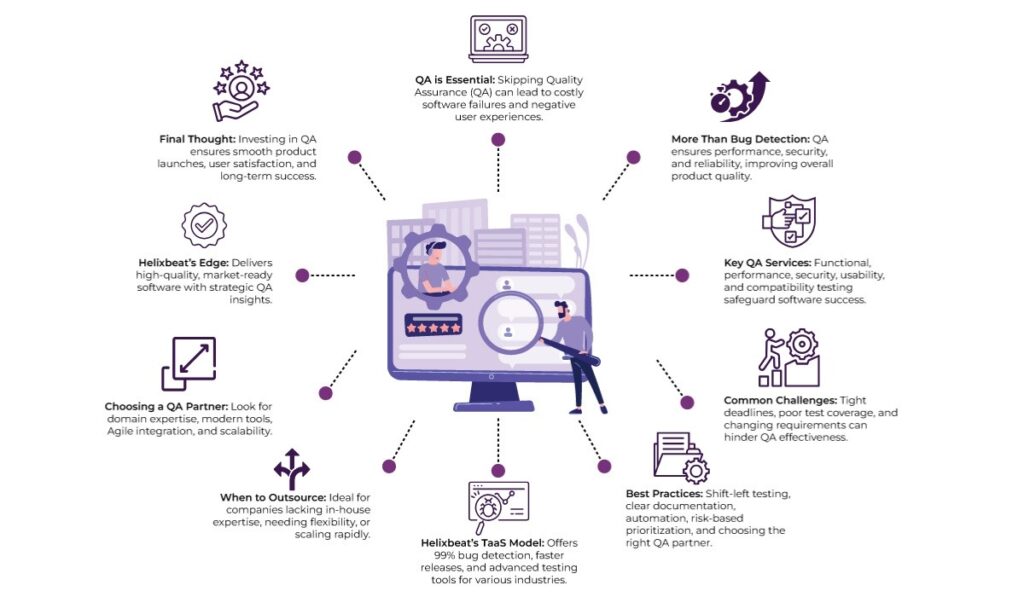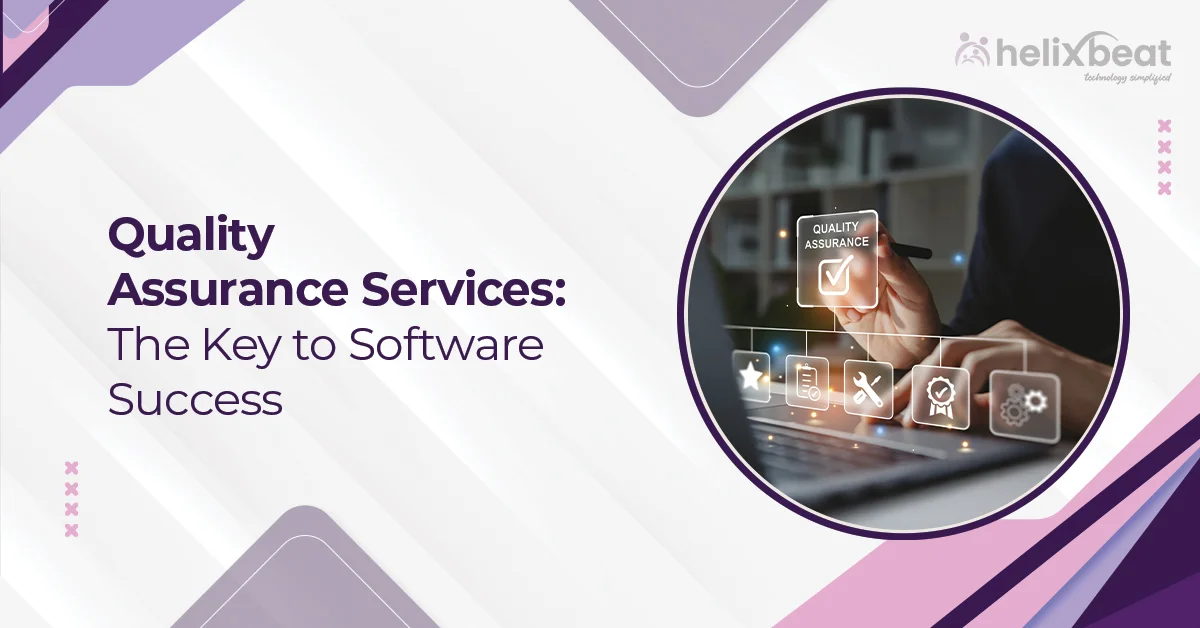Let’s imagine a scenario. Your development team spends months building an app. Everything seems great internally. But on launch day, users start complaining—pages won’t load, transactions fail, and the app crashes frequently. Within hours, negative reviews pile up, downloads drop, and your team scrambles to fix the issues
This isn’t a rare occurrence—it’s exactly what happens when Quality Assurance Services are overlooked or treated as an afterthought.
Every business that builds software—whether it’s a customer-facing app or an internal system—needs rigorous software quality assurance. It’s the foundation that separates a buggy release from a successful product launch. And with digital experience playing a critical role in shaping brand reputation, there’s no room for compromise.
So, how can you embed QA into your development lifecycle? And what are the best practices for delivering consistently high-quality results?
Table of Contents
Why Quality Assurance Services Are More Important Than Ever?
With software becoming the lifeblood of operations, products, and services, even a minor flaw can cost a business significantly. Quality Assurance Services are no longer just about bug detection—they’re about ensuring performance, building trust, and driving long-term customer satisfaction.
Here’s what they bring to the table:
- Improved User Experience: QA helps deliver a seamless and intuitive product.
- Faster Time-to-Market: Identifying bugs early reduces delays.
- Reduced Maintenance Costs: Preventing issues is far cheaper than fixing them later.
- Compliance and Security: QA ensures your software meets industry standards.
When software is a business asset, QA testing services help protect it.
What Do Quality Assurance Services Include?
Effective Quality Assurance Services go far beyond a few test cases. Here’s what a robust QA framework typically involves:
1. Functional Testing
Functional testing is the foundation of any software quality assurance process. It verifies that every feature operates as intended under various conditions. Testers check whether buttons, forms, and links perform correctly, and whether users can complete tasks without encountering errors. Additionally, this testing confirms that the system reacts appropriately to different types of user input.
Example: In a fintech application, functional testing is essential to validate user registration, secure login, and smooth transaction flow—critical operations that must perform flawlessly.
2. Performance Testing
Performance testing measures how well an application behaves under various load scenarios. This includes stress testing, load testing, and stability checks. It identifies bottlenecks, response time issues, and memory leaks, ensuring the software can support real-world user traffic.
Example: For an e-commerce app running a flash sale, performance testing ensures the platform remains stable and responsive when thousands of users access it simultaneously.
3. Security Testing
Security testing is a core component of Quality Assurance Services, especially for applications handling sensitive data. It identifies vulnerabilities such as insecure data storage, unprotected APIs, and weak authentication mechanisms. This type of testing is essential to prevent breaches and meet compliance standards.
Example: In a healthcare application, QA testing services must include thorough security checks to protect patient records and comply with regulations like HIPAA.
4. Usability Testing
This testing ensures the product is user-friendly, intuitive, and accessible. QA teams evaluate navigation flow, UI consistency, and design logic. They also check if the product accommodates users with disabilities.
Example: A food delivery app should allow users of all ages to place orders easily, with clearly labeled icons and streamlined steps.
5. Compatibility Testing
Compatibility testing verifies that the application functions correctly across various devices, operating systems, screen sizes, and browsers.
Example: A travel booking platform must deliver consistent performance on Android and iOS smartphones, tablets, and desktop browsers to reach the widest audience effectively.
Common Challenges in Software QA and How to Overcome Them
Even the best teams face challenges when implementing QA. Here are the most frequent ones—and how QA testing services can help tackle them:
1. Tight Deadlines
When teams rush to meet release dates, Quality Assurance Services are often minimized or skipped entirely, increasing the risk of post-launch defects. To address this, integrating software quality assurance into agile development workflows from the start allows for incremental testing, reducing last-minute pressure.
2. Lack of Test Coverage
Relying solely on manual testing can leave critical gaps, especially in complex or data-driven applications. By combining manual efforts with automated QA testing services, businesses can expand test coverage, improve reliability, and detect issues early across multiple scenarios.
3. Changing Requirements
Shifting project scopes can break existing features. Continuous regression testing, powered by a robust software quality assurance framework, ensures stability despite frequent changes. QA testing services can adapt quickly, helping teams maintain consistent product quality throughout development.
Best Practices for Successful Software Quality Assurance
Implementing Quality Assurance Services isn’t just about having a QA team—it’s about following practices that make QA efficient, reliable, and value-driven.
1. Shift-Left Testing- Incorporate testing at the earliest stages of development. By integrating QA into development sprints, teams can identify and fix defects before they become costly issues. This proactive approach reduces delays and improves software quality assurance outcomes.
2. Maintain Clear Documentation- Well-documented test plans, bug reports, and user stories create transparency and streamline team communication. QA testing services rely on this clarity to ensure every requirement is tested and every issue is traceable.
3. Automate Where It Makes Sense- Automation enhances efficiency for repetitive tasks like regression testing, functional flows, and performance assessments. However, over-automation can waste resources, so it’s important to balance manual and automated testing within your software quality assurance strategy.
4. Prioritize Testing Based on Risk- Focusing on high-risk areas—such as payment gateways or data security—maximizes QA impact. QA testing services help evaluate which components need more attention based on business-critical functions.
5. Choose the Right QA Partner- When internal resources are limited, outsourcing Quality Assurance Services to a trusted partner like Helixbeat ensures consistency, speed, and better ROI.
How Helixbeat Elevates Quality with TaaS (Testing as a Service)
Helixbeat offers a full-stack suite of Quality Assurance Services through its TaaS model, designed to support businesses of all sizes. Whether you’re building enterprise-grade applications or lean startup platforms, Helixbeat scales to meet your needs.
Here’s what sets them apart:
- 99% Bug Detection Rate – Identifies and resolves issues before they reach your users.
- 25% Faster Release Cycles – Enabled by agile QA methodologies and automation.
- 20+ Advanced Testing Tools – Including Selenium, JMeter, Appium, and more.
- Custom Solutions Across Industries – Tailored QA for healthcare, fintech, retail, and more.
- Flexible Engagement Models – Choose from Dedicated QA Teams, On-Demand Testing, or Managed Testing Services.
Partnering with Helixbeat allows you to focus on building your product, while they ensure it’s market-ready, high-performing, and reliable.
When Should You Consider Outsourcing QA?
Outsourcing Quality Assurance Services can be a strategic decision in the following scenarios:
- You lack in-house expertise.
- Your testing needs fluctuate.
- You’re scaling quickly and need faster releases.
- You want unbiased, third-party validation.
Outsourcing doesn’t mean losing control—it means gaining flexibility, speed, and software quality assurance without the overhead.
What Makes a Good QA Testing Partner?
Not every QA testing services provider delivers the same value. When evaluating potential partners, consider the following:
- Domain Expertise – Do they understand your business and industry challenges?
- Tool Proficiency – Do they utilize modern and efficient testing tools?
- Agile Capabilities – Can they seamlessly integrate with your DevOps or Agile workflows?
- Scalability – Can they scale as your product and business grow?
Helixbeat checks all these boxes and brings a layer of strategic insight to every engagement.
Final Words
Quality defines success in a digital-first world. Don’t wait for bugs to ruin your launch—prevent them with expert QA. Helixbeat’s QA Testing Services help you deliver faster, safer, and more reliable software. Ready to build better products? Partner with Helixbeat and make quality your competitive edge.

FAQs
1. What are Quality Assurance Services in software development?
They include a set of processes and testing techniques that ensure a software product meets the required quality standards before release.
2. How do QA Testing Services differ from software testing?
Software testing is part of QA, focusing on identifying bugs. QA covers the entire process, from planning to defect prevention.
3. Why are Quality Assurance Services important?
They help deliver stable, secure, and high-performing software that meets user expectations and business goals.
4. When should QA be introduced in the development cycle?
Ideally, QA should be integrated from the early stages of development (shift-left approach) for maximum effectiveness.
5. What types of testing are included in QA services?
Functional, performance, security, usability, compatibility, and regression testing are all common QA services.
6. Can small businesses benefit from software quality assurance?
Absolutely. QA is crucial for startups and SMEs looking to build reliable, scalable products.














